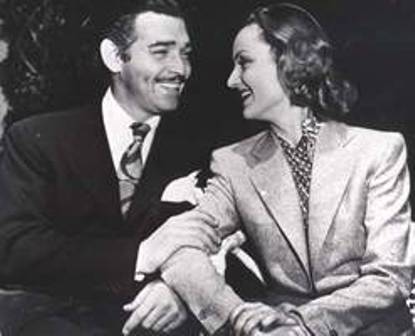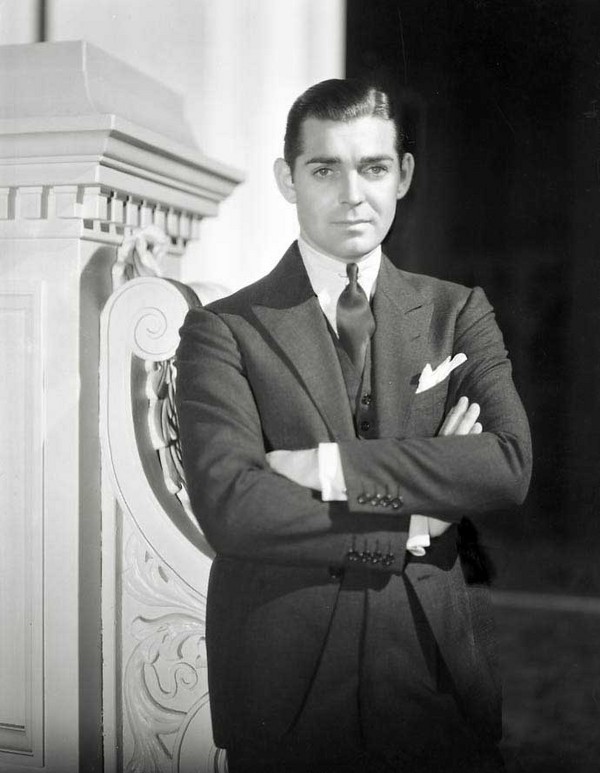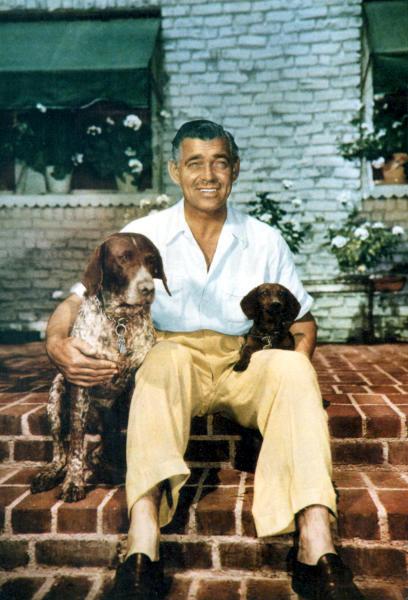{New Article} 1939: Will Carole Lombard’s Marriage End Her Career?
This 1939 article, written soon after Clark Gable and Carole Lombard’s marriage, is very sexist. Okay, extremely sexist. But it was 1939 after all and so one has to quiet their inner feminist as they read things like…
Carole Lombard, who was born Jane Peters, decided early in life that she had to do things to get places. She has devoted herself, through every working minute, to that aim. She has always wanted to be a star. She worked at it, and became a star. She built up the most amazing make-believe personality Hollywood has ever known, but she did it because she wanted something and that was her analysis of the way to get it.
With that realization, you will realize that the creature you called Carole Lombard was just as make-believe a creature as the characters she played on the screen. She was acting the role of Carole Lombard off the screen precisely as she was acting the scenario-writer’s roles onscreen. And so, in the final analysis, the “screwball” Carole isn’t the real Carole.
Clark Gable, on the other hand, is legitimately Clark Gable, all the way through. Gable has never put on an act. He has always been himself—because that self was precisely what screen fans demanded. Clark Gable didn’t fit a screwy personality into a pattern. Clark Gable’s REAL personality fitted into the pattern of what the screen needed. And so the Gable you know is the real Gable.
So what?—so here you have two individuals, married and their lives joined. You have a make-believe personality hitched to a real personality. And it is simply and inescapably inevitable that the “screwball” personality is going to collapse under the strain. The dominant real personality of Clark Gable will absorb the brilliant make-believe personality of Carole Lombard. And what’ll happen—there’ll finally be just Clark and Carole Gable. There’ll be a swell guy and a swell woman—a woman who is the real girl that Clark Gable married; not the clowness (is there such a word?) as the Carole Lombard you’ve come to accept.
For underneath that trick Carole, you see there has always been a real woman. And it’s that real woman that few people in Hollywood knew or know. It was given Clark Gable to be one of those people. And it wasn’t the artificial Carole he fell in love with; it was the real woman underneath. And Carole, being above all a very smart woman, knows that—and what she’ll give Clark Gable as his wife will be NOT the phony Carole Lombard, but the real “Ma” that Gable loves.
She has confessed to her intimates that there’s nothing she’d like more than to have Clark ask her to quit the screen; to have babies; to just be his wife. After all, why shouldn’t she? All her life she’s worked. She never knew a free, unplotted childhood. She began making movies when she was just a kid in school clothes. She’s been acting ever since—working, always working, for this Hollywood racket isn’t just a 40-hour week; it’s a
24-hour-a-day, seven-day-a-week job. And Carole must be tired of working after all these years.
I honestly believe that these paragraphs would displease Carole. She was not fake! In fact, her least favorite kind of person was a phony. The screwball thing wasn’t some act she put on for show, it was who she was. I think it is understandable that as she got older and more mature and became a married woman, the “screwballiness” faded a bit. Just because she found a man she loved and wanted to marry him and stay home and have his babies does not mean that the person she was before that was fake. It’s right about Clark being completely real and taken at full face value, but boy do I find this wrong about Carole. “A make believe personality hitched to a real personality”? Harsh.
pal, the day after she and Clark got back from their elopement.
And right here and now, I imagine, it’s time to debunk a lot of the applesauce and hone you’ve been hearing about that wedding trip of Clark and Carole.
Why, over the radio only a few nights after the marriage, I heard a bleating that the reason Clark and Carole picked that particular day to elope was that most of the newspaper reporters and writers in Hollywood were away—they were up in San Francisco, on a studio-arranged junket to see a preview of Alexander Graham Bell and attend the San Francisco Fair.
And because of that, Clark and Carole sneaked away like a couple of guilty kids and married in a hush-hush atmosphere.
To that, I say HOOEY! I happen to know that Clark and Carole had it all planned out for weeks and that they knew they could get away with a quiet, dignified wedding any day they wanted to, even if all the reporters in the world were concentrated in Hollywood. It was purely coincidental that the day they finally did drive off and do it happened to be a day on which some reporters were out of town.
You see, Clark had picked Kingman, Arizona, months ago. He’d hunted and fished around that country, and he liked the town. He liked the little First Methodist Church there. And right there, notice this: Clark and Carole never had any idea other than to be married by a minister. This justice-of-the-peace stuff might be all right for Hollywoodsters who were just getting married for a gag, but for Clark Gable, a justice wasn’t enough. They’d decided, right from the beginning, on a minister.
Besides, both of them wanted to get away from the usual Reno or Las Vegas stuff. So many of Hollywood’s screwiest marriages have been what they quaintly call “solemnized” in these places that Carole and Clark, in love and feeling deeply about it, didn’t want any of the scent of that sort of thing to attach itself to their own wedding. So Clark picked Kingman.
So having picked the place, scanned the maps, and figured driving times, Clark and Carole knew very well that any day they felt like it, or the chance offered, they could drive to Kingman in a few hours, and get married without any of the phony fanfare that they both basically abhor. And there is another fine tip-off—that Clark and Carole, screwy as they’ve acted for the sake of publicity and fun in the past, wanted their marriage to be utterly dignified and plain and honest and sincere and fine. You see, this marriage is no gag!
Well, there came Clark’s awaited “day off” from being Rhett Butler in GWTW. Carole wasn’t working. So that night before, they made their last arrangements—
Clark, his heart thumping like a guy who hadn’t spent years playing torrid love scenes, went to a florist and bought a corsage and tow boutonnieres! He bought a plain corsage—two pink roses and a spray of lily of the valley—for two reasons: first, because it was to be in keeping with their simple, fundamentally nice and fine wedding, rather than “orchidy” and flamboyant; second, because a more fancy corsage might have been a tip-off to a snooping press.
You see, in Hollywood, even florists and florists’ attendants are paid for being sideline reporters; if they can slip a tip to a radio caster or a columnist, they get a few bucks. So Clark, wise in the ways of Hollywood, bought a simple corsage that wouldn’t occasion any wonderment.
The two boutonnieres—one pink rose was for himself, and the other for his friend, Otto Winkler, a former newspaperman who has become one of Clark’s intimate friends and companions. It was Otto who was to go with them and help drive those few hundred sandy, hot dusty miles to Arizona.
They shoved off at 8:45 that morning. They got to Kingman seven hours later. All the way, they weren’t recognized, even though they weren’t hiding behind dark glasses. It was only a few minutes’ activity in Kingman that finished the business—a very thrilled girl named Viola Olson, clerk in the courthouse, gave them their license.
Then they hurried over to Dr. Engle’s parsonage at the Methodist Episcopal Church. Otto was the best man. Mrs. Engle was bridesmaid. The city clerk and Viola Olson and a Fred Cate served as witnesses, and they’ll probably be talking about it for the rest of their lives. That was all. It was simple; it was dignified; it was so doggone clean and sweet and unphony that Otto said it was all he could do not to bawl.
Afterward?—well, Clark and Carole called up a few people. They called the studio and told them what they’d done. They called a few close friends among the news folks and told them. They sent a few telegrams. By then, a couple of press-service correspondents in Kingman had heard about what was going on, and Clark and Carole told them the details. Then they got back in their car, and hurried back to Hollywood. No honeymoon; not yet.
Of course, by the time they got home, the news hounds were hot on their trail. Clark and Carole ducked to Carole’s house, which they’ll call home until they move into the house Clark bought from Raoul Walsh, out in San Fernando Valley. So many reporters clamored for interviews that Clark and Carole had to have two open hearings, taking them in relays. They posed for endless picture-taking. They answered questions. And that was all.
Clark himself said that they had not planned their wedding day, it just happened to be his day off from Gone with the Wind. And they weren’t married by a minister in a Methodist Church! They were married by a justice of the peace! Well at least this article didn’t start the rumor that Clark and Carole spent their honeymoon in Kingman, like is still believed.
You can read the article in its entirety in The Article Archive.




2 Comments
Mary
As you said, it is ‘of its time’. Carole Lombard was real. If anything it was Clark who wasn’t, who had invented the Clark we know. I think that a lot of people of the time would have wondered where the writer was coming from. Was it a man or a woman who wrote this? How wide was its publication?
Still, interesting to read.
Thanks for publishing it
Pingback: